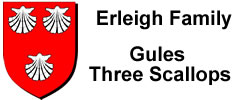Edward Earle Line
Edward Jr. was born in 1665 he would be about 23 years old when Married. Name: Edward Earle Y. M. Gender: Male Marriage Bann Date: 29 Jan 1688 Marriage Bann Place: Bergen, New Jersey Marriage Date: 13 Feb 1688 Marriage Place: Bergen, New Jersey Spouse: Elsje Vreeland Comments: from Maryland, living on Sicakis Island. from Gemonepa, living at Minkachquee Additional Comments: by Rev. Henricus Jansz Selyns of New York
Edward Earle and Judge Pinhorne jointly held the Secaucus property until April 15, 1682, when they split it in half, with Earle taking the upper portion and Pinhorne the lower 1800 acres or so. “Pinhorne’s property went from, [Paterson] Plank Road or a little lower, right down to the mountain, the Snake Mountain,” said Hassard, referring to what is now Laurel Hill.
Edward Sr. sold to Judge William Pinhorne, on March 26, 1679, for 500 pounds, one undivided half of the tract, also one half of the stock,” according to records. Included in the transaction were one two-story house, five tobacco houses, some livestock and “between thirty and forty hogs, foure Negro men, five Christian servants.” The sale was likely made to secure Pinhorne’s influence in maintaining title to the land against other colonial claimants, since Judge Pinhorne was a prominent politician at the time.
The completion of the sale and transfer of the Island of Secaucus to Edward Earle took place on April 24, 1676. We know that Edward Sr. was in New York for several years before he acquired possession of Secaucus. In the deed he is described as “Edward Earle of New Yorke, Planter.” The word “planter” is used because Edward Earle had owned a plantation with Joseph Dockings in Maryland.
Edward Sr. came to New York not later than the autumn of 1673. He had already entered into an agreement to purchase Secaucus Island. On the 16th of October of 1673 Edward signed articles of agreement providing for the conveyance to him of the Island of Secaucus, N. J. That such a transfer of ownership agreement was in place is shown by an opinion of William Samuel Johnson in 1673 as to the ownership of the Common Lands set off to the Island of Secaucus, then in possession of Edward Earle.
Joseph Dockings appears in a list of the freeholders of Calvert County in 1671, but the name of Edward Earle, who had been associated with him, does not appear. This would indicate that he no longer had any land interest left in Maryland.
The birthdate for Edward Jr.is estimated based on his marriage record which states he was born in 1665. He may have been born in Maryland or New York, but there is no known birth record for Edward Jr. Earle.
Edward Sr. married Hannah Baylis (from New York) in 1665 when he was 37 years old and she is estimated to be about 25 years old. If she was 25 years old at the time of her marriage that would make her 12 years younger than Edward. We do not know where they were married but family speculation has always been that they were married in Maryland since that is where Edward was living.[5] Name: Edward Earle Gender: Male Birth Year: 1628 Spouse Name: Hannah Baylis Spouse Birth Year: 1640 Marriage Year: 1665
1664 the British take over Dutch controlled New Amsterdam, renaming it New York, with the area west of the Hudson becoming the Province of New Jersey bringing the whole area under British rule. It is possible that Edward Sr. left Maryland and went to New York in 1664/1665 right after the British took control of the area. This is probably where he met Hannah Baylis. We know he married Hannah Baylis in 1665 and at that time her family were living in Jamacia, Queens, New York.
The first land record we have of Edward Earle is in Calvert County Maryland about 1664 (age 36) as a bachelor. (Calvert County formed by order in the Council of Maryland 10 years earlier in 1654.) The Commissioner of the Land Office at Annapolis, Md., states that on the 28th of November, 1664, Joseph Dawkins (abt.1635-1685) (Dockings) assigned 150 acres of land to Edward Earle. He also states that “Bachelor’s Hall,” in Calvert County, Md., containing 300 acres, was patented by Joseph Dockings and Edward Earle on September 15, 1665.
